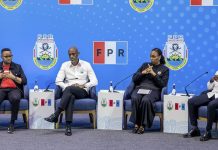Africa-Press – Rwanda. The Rwanda Media Barometer (RMB) 2021 has indicated that the media development and professional capacity indicator scored 62.4 per cent, the least performance compared to other indicators it considered.
This media development and professional capacity performance implies a 10 per cent drop compared to the previous RMB which was published in 2018 in which it was recorded at 72.4 percent.
RMB 2021 was launched by the Rwanda Governance Board (RGB) on Tuesday, November 23, 2021. RMB is a tool that gauges the state of media development in Rwanda.
It was based on findings from questionnaires administered to over 800 respondents including 652 ordinary citizens and 165 journalists and Media Civil Society Organisations (CSOs). Desk research, Key informant interviews, and focus group discussions also contributed to the findings.
The launch of RMB 2021 coincided with the celebration of the Africa Day of Information (ADI), under the theme: Media Professionalism and Information Access in the Digital Era: Literacy, Data Protection & information accessibility.
Previous editions of the Rwanda Media Barometer indicated a steady and positive improvement of media development status from 60.7 percent in 2013 to 69.6 per cent in 2016 and 72.4 percent in 2018.
While presenting the findings of the RMB 2021, Jean Bosco Rushingabigwi, Head of Department for Media Sector Coordination Monitoring at RGB said that the least performing sub-indicators which are below 70 percent are all under the media development and capacity indicator, and “are areas where we need more efforts in the future to make our media vibrant and professional and sustainable.”
Under the media self-regulation sub-sector, the aspect of independence of the media self-regulatory body, the Rwanda Media Commission, got 37.6 percent. Under the media industry viability and financial sustainability, media profitability scored 21.3 per cent.
Joseph Hakuzumuremyi, the Managing Director of Umuryango.com, a local online-based media outlet, said that financial constraints were some of major challenges to the media sector. Commenting on media profitability, he said that the media was lacking an entity that is devoted to its development.
“The money that media houses get is that to help them remain afloat, apart from those public media houses that get a share from taxpayers’ money and again get revenues from advertisement,” he said, adding that some journalists lack salaries.
Berna Namata, the Country Manager of Nation Media Group said that for the media professionals to be able to tap into the enormous opportunity brought about by digital platforms and be profitable, they have to invest in good journalism ‘to create content that is engaging and relevant”.
“If you have to maintain a professional journalist in the newsroom, you have to pay them well, you have to pay them as well as you pay your lawyer, as well as you pay your doctor,” she said calling for the empowerment of the media through investments and respect rights of journalists.
Usta Kaitesi, CEO of Rwanda Governance Board Kaitesi said that the drop was a result of the fact that some of the journalists said there was reduced financial capacity, among other factors. However, she added that the media development and capacity assessment extended the scope of factors that contributed to the fall in performance.
Usta Kaitesi, CEO of Rwanda Governance Board during the launching the Performance of Rwanda media development on November 23, 2021. Dan Nsengiyumva
Kaitesi said that issues affecting media development can be addressed through engagement with media practitioners and partners. “If we work together, in the next two years we will be celebrating achievements made in addressing these issues,” she observed.
Performance of some other indicators
The media barometer tracked five indicators, namely legal and policy framework ( which scored 91 per cent), media plurality and diversity (87 per cent), media as a platform for strengthening governance and democracy (85 per cent), media development and enhancing capacity (62.4 per cent) and access to information (77.8 per cent).
Group photo during the launching the Performance of Rwanda media development on November 23, 2021. Dan Nsengiyumva
According to this barometer, freedom of the press in Rwanda is at 93.7 per cent while freedom of expression is 86.4 per cent – both being sub-indicators of the legal and policy framework.
In 2018, the sub-indicator of ‘media freedom’ had an overall score of 77.1 percent, while that of Freedom of Expression was 90.8 percent. Oswald Mutuyeyezu, a journalist for Radio/TV 10, said that paying journalists could not score 70 percent, arguing that the reality would prove that this performance is exaggerated.
“You cannot be independent when you get revenues from advertisement. Almost all media houses in Rwanda are commercial, including the public broadcaster,” he said citing media advertisement deals with major telecommunication and beverage companies in the country.
“We (the media) cannot be free at 93.7 percent when we are not financially independent,” he said.
For More News And Analysis About Rwanda Follow Africa-Press






